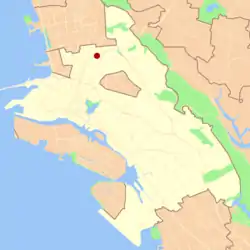Lorin District, Berkeley, California
Lorin | |
|---|---|
 Location of Lorin in Berkeley | |
| Coordinates: 37.850978°N 122.274232°W | |
| Country | United States |
| State | California |
| County | Alameda |
| City | Berkeley |
The Lorin District (also known as the Lorin Streetcar District) is a neighborhood located in the southern part of Berkeley, California, bounded by Ashby Avenue to the north, Adeline Street and Martin Luther King Jr. Way to the east, Sacramento Street to the west, and 62nd Street to the south. Today, the area is today mostly referred to as "South Berkeley".
History
The land was first populated by the Ohlone Native Americans, who were displaced by Spanish settlers in the 1700s.[1] It was unincorporated as the town or settlement of Lorin, and was the last stop before Berkeley along the Berkeley Branch line of the Central Pacific (later, Southern Pacific). In 1892, the people of Lorin elected to be annexed to the City of Berkeley.
While Lorin supported a large Japanese immigrant population in the early 20th century, many such residents were forcibly removed to internment camps during WWII. After their displacement, many Black migrants from the American South settled in the district.[2][1]
In the 1930s, the Lorin District was redlined by the federal Home Owners’ Loan Corporation, leading to decades of underdevelopment and government disinvestment.[3]
In popular culture
Lorin is the setting for a scene in former University of California student Frank Norris' book The Octopus (1903).[4]
References
- "Historic 'Lorin District'". Historical Marker Database. Retrieved 25 April 2023.
- Hurwitt, Sam (21 June 2006). "South Side Story". East Bay Express | Oakland, Berkeley & Alameda. Retrieved 25 April 2023.
- Barber, Jesse (20 September 2018). "Redlining: The history of Berkeley's segregated neighborhoods". Berkeleyside. Retrieved 25 April 2023.
- Google Books: the Octopus pg. 584